Article Information
- GuoYu Li, Wei Ma, Fei Wang, YanHu Mu, YunCheng Mao, Xin Hou, Hui Bing. 2015.
- Processes and mechanisms of multi-collapse of loess roads in seasonally frozen ground regions: A review
- Sciences in Cold and Arid Regions, 7(4): 456-468
- http://dx.doi.org/10.3724/SP.J.1226.2015.00456
Article History
- Received: February 20, 2015
- Accepted: May 11, 2015
2. University of Chinese Academy of Sciences, Beijing 100049, China;
3. Communication Research Institute of Gansu Province, Lanzhou, Gansu 730050, China
1 Introduction
Typical loess is a type of Quaternary deposited silt which exhibits a sudden collapse upon wetting due to its structure. It can be termed as "collapsible loess" when its coefficient of collapsibility(similar to collapse index)is greater than 0.015(PRCMC, 2004). Here, the coefficient of collapsibility or the collapse index is defined as the relative magnitude of a confined loess collapse during wetting at a constant vertical stress. Loess is widely distributed in the world, accounting for 9.3% of the l and area in North America, southern Russia, northern France, Canada, Australia, the Middle East, Western Europe, and northwestern China. In China, loess and loess-like sediments occupy a l and area of 630, 000 km2, where the collapsible loess accounts for more than 60% of the total(Sun, 2005). Generally, in northwestern China, typical loess is located in arid or semi-arid areas where freezing and thawing frequently occur.
Collapsible loess can be used as a cheaper fill material for road embankments, and can meet the strength requirements following dense compaction and the elimination of collapsibility. However, problems such as pavement cracks, differential settlement, hidden caves, slope l and slides, and shoulder movement can still occur after several years of operation. These secondary or multiple collapses(here, both are referred to as multi-collapses)adversely affect road performance and significantly increase the maintenance cost. Many investigations have shown that the multi-collapses of loess roads are caused mainly by repeated wetting-drying, freezing-thawing, and salinization-desalinization cycles in arid and seasonally frozen ground areas(Sillanpaa and Webber, 1961; Chamberlain and Gow, 1979; Nixon and Lem, 1984; Graham and Au, 1985; Kay and Dexter, 1992; Czurda and Hohmann, 1997; Bing and He, 2001; Derbyshire, 2001; Houston et al., 2001; Qi et al., 2006; Li and Zhang, 2009; Malusis et al., 2011; Chang and Liu, 2013; Zhang et al., 2013). With recent rapid development in western China, many other infrastructures have been built, such as the High Speed Highways(the Yongdeng-Gulang Expressway in Gansu Province and Xi'an-Baoji Expressway in Shaanxi Province of the National Highway No. GZ45, Pingliang-Dingxi Expressway in Gansu Province of the National Highway No. 22, Lueyang-Dashibei Expressway in Shaanxi Province of the National Highway No. G7011) and the Zhengzhou-Xi'an and Lanzhou-Urumchi High Speed Railways, airports, hydraulic engineered structures, and city subways. These infrastructures are also encountering problems associated with multi-collapse of foundation loess.
There are currently no reports in the literature on the processes, mechanisms, and countermeasures of multi-collapse of foundation loess in arid and seasonally frozen ground areas. Therefore, a research project spanning 2009 to 2016 was approved to systematically study them, jointly funded by the Ministry of Transport of the People's Republic of China, the Chinese Academy of Sciences(CAS), and the Gansu Provincial Science and Technology Department. The project involves the following objectives:(1)to elucidate the effects of wetting-drying, freezing-thawing, and salinization-desalinization cycles on the processes and mechanisms of multi-collapse of loess roads;(2)to assess the effects of combinations of wetting-drying, freezing-thawing, and salinization-desalinization cycles on those processes; and (3)to propose some countermeasures against multi-collapse and verify them in laboratory and field tests. Some of these works have been completed and others are still under way(Li et al., 2010, 2011, 2012; Mu et al., 2011). Advances to date and further research needs are described herein, which will support better underst and ing of loess collapse mechanisms and will provide a basis for studying the weakening mechanisms of similar structural soils.
2 Effects of wetting-drying cycles on processes and mechanisms of multi-collapse of compacted loessNumerous laboratory experiments, including wetting-drying, double Oedometer, and direct shear tests, have been done to examine the coefficients of collapsibility(the collapse index) and strengths of compacted loess samples following different wetting-drying cycles, to unveil the effects of wetting-drying cycles on processes and mechanisms of multi-collapse of loess roads.
2.1 Experimental methodLi et al.(2010, 2011, 2012)sampled collapsible loess near Yongdeng County(36°36¢34¢¢N, 103°22¢05¢¢E)in Gansu Province, northwestern China. The grain-size distribution and physical parameters were measured in the laboratory, as summarized in Tables 1 and 2.
| Diameter(mm) | 0.1-0.07 | 0.07-0.05 | 0.05-0.01 | 0.01-0.005 | 0.005-0.002 | <0.002 | |||||
| Percentage(%) | 0.1 | 10.2 | 49.3 | 37.2 | 1.2 | 2.0 | |||||
| Specific weight | Liquid limit(%) | Plastic limit(%) | Plasticity index | Max. dry density(g/cm3) | Optimum water content(%) | ||||||
| 2.72 | 26.9 | 18.7 | 8.2 | 1.91 | 11.6 | ||||||
Cylindrical samples(20 mm in height and 61.8 mm in diameter)were densely compacted and formed by a compressing device in a steel mold. The water content and dry density of the soil samples were close to the maximum and the optimum, respectively. The compacted loess samples were wetted up to a saturated state by adding distilled water using a buret. Then they were dried to a natural water content of 5% by bath heaters. This process comprised a full wetting-drying cycle. After wetting, the samples were sealed with rubber membranes and consolidated for 12 hours for uniform water distribution. The samples were subjected to 0, 1, 5, 10, 20, and 30 wetting-drying cycles. Then Oedometer and direct shear tests were conducted and the coefficients of collapsibility and cohesion were derived to study effects of wetting-drying cycles on secondary and multiple collapse and strength.
2.2 Effect of wetting-drying cycles on coefficient of collapsibilityThe coefficients of collapsibility were calculated after various wetting-drying cycles and Oedometer tests. The relationship between the coefficients of collapsibility and the number of wetting-drying cycles at different stresses of 50, 100, 150, and 200 kPa, respectively, is shown in Figure 1.
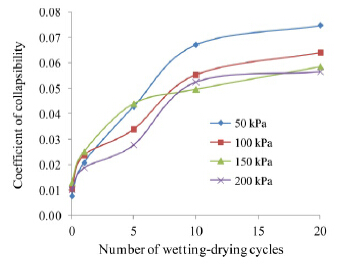 |
| Figure 1 Coefficient of collapsibility of compacted loess versus number of wetting-drying cycles |
The coefficients of collapsibility of the compacted samples not subjected to any wetting-drying cycle, at different stresses, were all lower than 0.015, a threshold defining a collapsible loess(GB50025-2004, 2004), which shows that the compacted loess did not exhibit significant collapse. After certain numbers of wetting-drying cycles, the coefficients of collapsibility exceeded 0.015 at different stresses, which shows that the compacted loess samples exhibited the secondary collapse after wetting-drying cycles. The coefficient of collapsibility progressively increased with additional wetting-drying cycles.
2.3 Effect of wetting-drying cycles on strengthDirect shear tests were performed on compacted samples after different numbers of wetting-drying cycles, to calculate cohesion in order to study the effect of wetting-drying on strength. To avoid uncertainties associated with sample preparation and testing, two or three replicates were made at each number of wetting-drying cycles. Calculated cohesion versus number of wetting-drying cycles is plotted in Figure 2. Note that the cohesion decreased with additional wetting-drying cycles. The average cohesion for the samples not exposed to wetting-drying cycles was 28.4 kPa. However, it decreased by 83% of the initial value, reaching as low as 4.8 kPa after 30 wetting-drying cycles. This demonstrates that wetting-drying cycles rearrange the soil particles and remarkably weaken the strength of compacted loess.
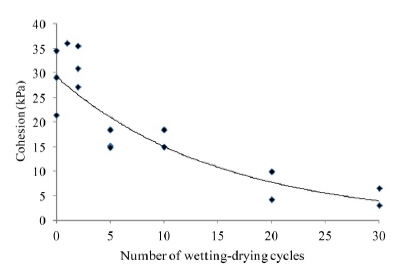 |
| Figure 2 Change in cohesion with increasing number of wetting-drying cycles |
Freezing-thawing tests in an open system(with water supply)can enhance the heterogeneity of moisture in soils, which then causes uncertainty in physical and mechanical parameters. Therefore, open freezing-thawing tests were performed in order to study their effects on water redistribution, dry density, void ratio, collapse, and micro-fabric in different portions of the soil samples. Some closed freezing-thawing tests were also done only to study the effects of freezing-thawing cycles on strength, because heterogeneity in samples is not allowed when strength parameters are measured.
The collected loess was compacted layer by layer into samples with optimum water content of 11.6% and a dry density of 1.86 g/cm3, which was close to the maximum dry density of 1.91 g/cm3. The compacted cylindrical samples were 10.13 cm in height and 10.1 cm in diameter. The top temperature varied in the range of −6.7 °C to 27 °C according to the field conditions(Li et al., 2010). The bottom temperature was set at 1 °C. The sample bottom was connected to a water reservoir to simulate the natural groundwater condition(Li et al., 2011). The soil temperatures were measured at vertical intervals of 1 cm during freezing and thawing. The water content was measured layer by layer at the frozen state immediately after the freezing-thawing cycles to analyze water distribution along the height of the samples. That measurement interval was also 1 cm. Finally, the dry density, micro-fabric, and collapse were measured in the upper and lower portions of the samples, respectively.
The loess samples for the closed freezing-thawing tests were slightly smaller than for the open freezing-thawing cycles, 12.5 cm in height and 6.18 cm in diameter. They were also compacted layer by layer with optimum water content of 11.6% and a dry density of 1.8 g/cm3. The sealed samples were exposed to freezing-thawing cycles in a modeling box. The air temperature in the modeling box was controlled automatically and it varied in the range of −30 °C to 30 °C(Li et al., 2012). After different numbers of freezing-thawing cycles, soil samples were taken out of the modeling box and unconfined compression(UC)tests and unconsolidated-undrained triaxial compression(UUTC)tests were performed to measure the strength parameter to investigate the effects of freezing-thawing cycles on the strength.
3.2 Effect of freezing-thawing cycles on water redistributionWater content distribution along the soil height is shown in Figure 3. Note that the water contents at various heights were in excess of the initial value of 11.6% and gradually increased with the increasing number of freezing-thawing cycles. Along the height, water progressively moved up after freezing-thawing cycles and accumulated at a certain height. Water content by weight in the lower portion varied between 15.09% and 7.90%. In the upper portion, it varied between 21.87% and 28.47%. These results show that the freezing-thawing cycles led to water content redistribution and accumulation in the upper portion of the soil height.
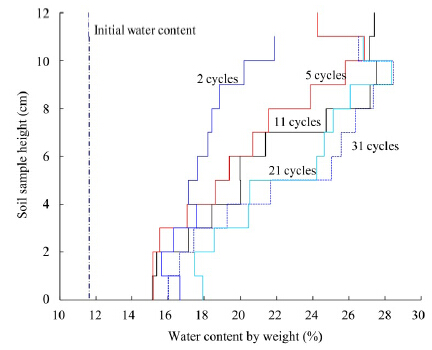 |
| Figure 3 Water content distribution along the height of soil samples |
The upper and lower portions, 3-5 cm from the top and bottom of the soil samples, were taken for measuring their weight and water content to calculate their dry density and void ratio. The dry densities in the upper and lower portions at different numbers of freezing-thawing cycles are shown in Figure 4. The dry density decreased with increasing numbers of freezing-thawing cycles. The dry density of the upper portion decreased more quickly during the first several freezing-thawing cycles because the upper portion suffered from not only freezing-thawing cycles but also wetting-drying cycles. However, the lower portion only suffered from wetting-drying cycles. The dry density of the upper portion became constant after 21 freezing-thawing cycles, from the initial value of 1.86 g/cm3 to 1.55 g/cm3. These results show that repeated freezing-thawing cycles and wetting-drying cycles led to reduction in density.
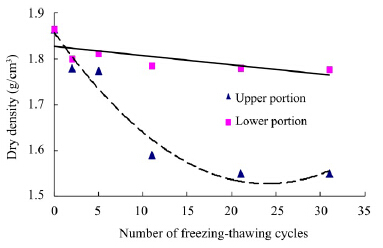 |
| Figure 4 Change in dry density with increasing number of freezing-thawing cycles |
Figure 5 shows the change in void ratio of loess samples with increasing numbers of freezing-thawing cycles. The void ratio gradually increased with additional freezing-thawing cycles, which shows that freezing-thawing cycles enlarged the pores and loosened the compacted loess. The void ratio of the upper portion increased more quickly than that of lower portion after a certain number of freezing-thawing cycles.
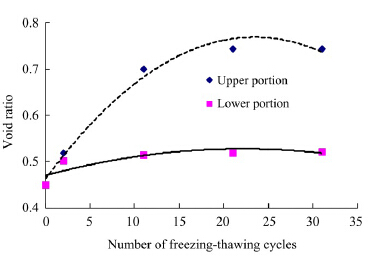 |
| Figure 5 Change in void ratio with increasing number of freezing-thawing cycles |
In order to study the effect of freezing-thawing cycles on the micro-fabric of compacted loess, a scanning electron microscope(SEM)was used to observe the change in micro-fabric of thin sections of soil samples after different numbers of freezing-thawing cycles, and to study the multi-collapse mechanisms from the microscopic view(Mu et al., 2011). The SEM microphotographs were binarized into either black or white according to a certain grey level(a grey threshold). The black and white areas represented pores and soil particles, respectively. Then the areal porosity could be quantitatively calculated and the pore area distribution could be plotted for analyzing the pore characteristics.
Figure 6 shows SEM images exhibiting changes in loess micro-fabrics after different numbers of freezing-thawing cycles. The freezing-thawing cycles enlarged the pores, and increased the number of larger pores with increasing freezing-thawing cycles(Hohmann-Porebska, 2002). Compacted loess particles not exposed to freezing-thawing were densely aggregated and their contacts were of the coagulation type, which was more stable, and its primary fabric was of a matrix type that was more isotropic. However, after many freezing-thawing cycles the loess particles became loosely aggregated and their contacts became less coagulated and metastable, and its primary fabric was of a skeletal-matrix type that was significantly anisotropic.
 |
| Figure 6 Typical SEM microphotographs showing micro-fabrics after different numbers of freezing-thawing cycles.(a)not exposed to freezing-thawing cycles;(b)after 2 cycles;(c)after 31 cycles |
Figure 7 shows the areal porosities in SEM images after different numbers of freezing-thawing cycles. The areal porosity increased with the increasing number of freezing-thawing cycles. After 11 freezing-thawing cycles, it slightly decreased and tended to be constant.
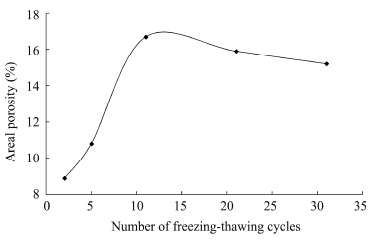 |
| Figure 7 Change in areal porosity with increasing number of freezing-thawing cycles |
Figure 8 shows the pore area distribution after different numbers of freezing-thawing cycles. Some pores in the compacted loess progressively became larger and the number of larger pores increased after more freezing-thawing cycles. These changes in the micro-fabric were in good agreement with the macroscopic behaviors discussed above.
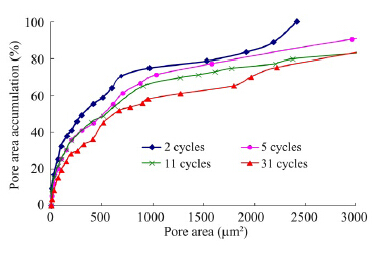 |
| Figure 8 Pore areal distribution of compacted loess samples after different numbers of freezing-thawing cycles |
These results show that freezing-thawing cycles led to contact change between the compacted loess particles, an increase in areal porosity and the number of larger pores, the occurrence of skeletal micro-fabrics, and a decrease in macroscopic density. These changes demonstrate that freezing-thawing cycles can enlarge pores and weaken the strength of compacted loess, and are one of the causes of multi-collapse of compacted loess.
3.5 Effect of freezing-thawing cycles on unconfined compressive(UC)strengthTo further study the effect of freezing-thawing cycles on the strength of compacted loess, unconfined compression(UC) and unconsolidated-undrained triaxial compression(UUTC)tests were performed after different numbers of freezing-thawing cycles in a closed system. Three soil specimens were subjected to strain-controlled UC tests after every freezing-thawing cycle at a constant axial strain rate of 2.4% per minute. Four soil samples were subjected to UUTC tests at a constant strain rate of 1% per minute.
Figure 9 shows that the UC strength responded to the number of freezing-thawing cycles. The UC strength gradually decreased with the increasing number of freezing-thawing cycles. After 31 freezing-thawing cycles, it decreased by 10.4%, on average, from the initial value of 181.3 kPa to 162.4 kPa.
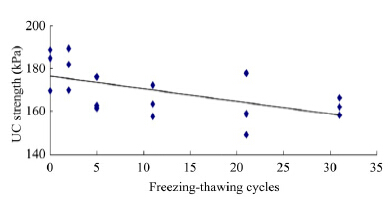 |
| Figure 9 Change in UC strength with increasing number of freezing-thawing cycles |
After the UUTC tests, the Mohr failure envelopes were plotted and the cohesions were determined after different numbers of freezing-thawing cycles. Figure 10 shows cohesion versus number of freezing-thawing cycles. Note that cohesion was considerably reduced due to increasing freezing-thawing cycles. After 31 freezing-thawing cycles, cohesion decreased by about 84%.
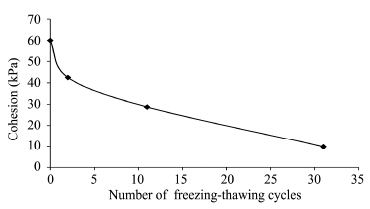 |
| Figure 10 Cohesion as a function of the number of freezing-thawing cycles |
Figure 11 shows UUTC strength(the maximum vertical stress)change with the number of freezing-thawing cycles. Note that the UUTC strength also gradually decreased with increasing freezing-thawing cycles, which also shows that freezing-thawing cycles weakened the strength of the compacted loess. With increasing confining pressure, UUTC strength gradually increased.
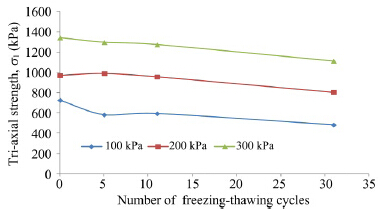 |
| Figure 11 Change in tri-axial strength with increasing number of freezing-thawing cycles |
Traditional mitigative measures against collapse of loess roads have focused on the prevention of initial collapse during the construction phrase by elimination of collapsibility, primarily by static or dynamic compactions, compaction piles, and chemical reinforcement. They rarely considered the secondary or multiple collapse of loess roads in the coming years. We proposed a new countermeasure(a new embankment structure)against both frost hazards and multi-collapse of loess roads(Figure 12a). Insulation boards were used in the upper part of a new embankment structure to reduce the frost depth in winter, thereby minimizing the frost hazards. Water-proofing geotextile was used in the lower part of the new embankment structure and under the side ditches to stop moisture migration from underground or from the side ditches; this can reduce the effect of wetting-drying cycles. Thus, this new embankment can effectively decrease the weakening effect of freezing-thawing and wetting-drying cycles on loess roads, and enhance their stability.
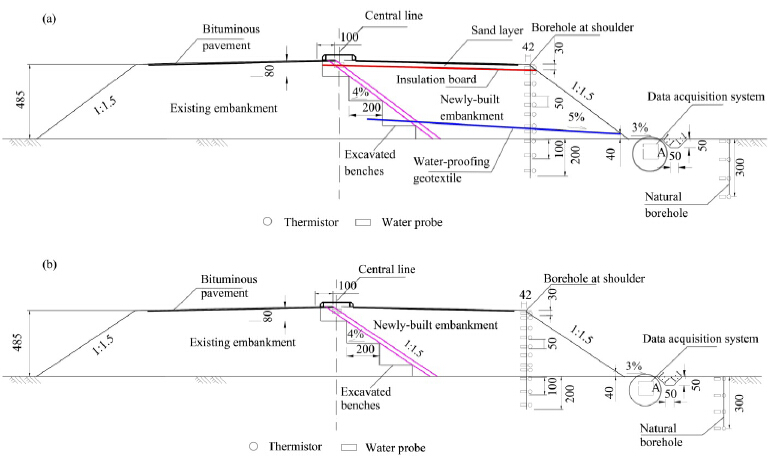 |
| Figure 12 Instrumentation in the new embankment and a control cross sections(unit: cm). (a)in the new loess embankment;(b)in the control cross section |
In order to verify the engineered effectiveness of this new embankment, laboratory and field tests were performed to examine the thermal insulating effect of the insulation boards and the water-proofing effect of the geotextiles(Mao, 2014).
The field-monitored sections in the loess embankment are located near Yongdeng County, Gansu Province, northwestern China. The existing highway needed be widened in the right side, so the insulation boards and geotextiles were placed only in the newly-built right portion shown in Figure 12a. Boreholes were drilled on the right shoulder of the loess embankment after construction, and some DTR(time domain reflectometry)water probes and thermistors were embedded in them at different depths. In order to compare the effectiveness of the new embankment, a control section(without insulation boards and geotextiles)was also built 50 m away from the new embankment section; the instrumentation is shown in Figure 12b.
4.1.1 Results of thermal regimesThe volumetric water contents and ground temperatures were measured during 2010-2013. The observed ground temperatures in the new embankment are shown in Figure 13. In winter, the ground temperatures above and under the insulation boards were markedly lower than near the insulation boards. They have a sudden change near the insulation boards. This shows that the insulation boards had a definite thermal insulating effect. The ground temperatures under the insulation boards were negative in winter because this borehole was located at the shoulder of the loess embankment. The cold air could freeze the shoulder of the embankment from the side slope. In summer, the ground temperatures in the upper portion of embankment were higher and they decreased gradually along the depth.
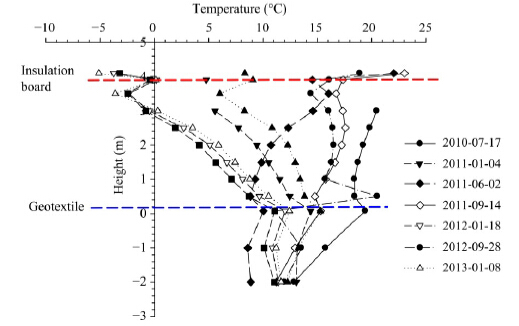 |
| Figure 13 Ground temperature profiles at the shoulder of the new road embankment |
The ground temperatures in the control cross section are shown in Figure 14. The ground temperatures had no sudden change along the depth, and they gradually decreased from the top toward the bottom of the embankment in summer, and the opposite occurred in winter. In the upper portion of the embankment, the ground temperatures varied in a large range. In the winter of 2012, the loess embankment was frozen to 1.2 m deep. This shows that the loess embankment experienced a certain number of freezing-thawing cycles.
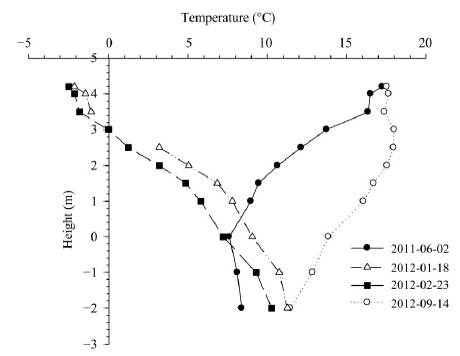 |
| Figure 14 Ground temperature profiles at the shoulder of the control cross section |
The measured volumetric water contents in the new embankment over time are shown in Figure 15. Note that the water contents in the embankment showed larger values and a larger range than under the original ground surface. For instance, at the height of 3.5 m, the water contents varied in a larger range from 7.0% and 33.6%. However, at the depth of −2 m, the water content varied in a smaller range from 13.3% to 15.7%. The larger water content in the upper portion was due to rainfall from side slopes in summer. Water contents in the embankment decreased in winter and rose in summer, which showed a slight seasonal undulation.
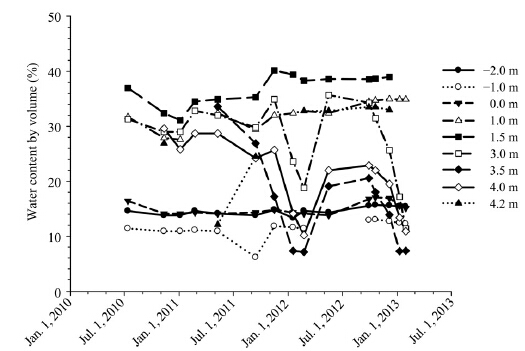 |
| Figure 15 Change in water content by volume with time in the new road embankment |
The observed water contents in the control cross section are shown in Figure 16, varying with time. The water contents varied more strongly than in the new embankment, decreasing in winter and increasing in summer. For instance, the top water content at the embankment height of 3.5 m varied from 6.4% to 29.0% during the period of November, 2010 to February, 2012. However, the water contents under the original ground surface varied less. For instance, the water content at the depth of −2 m beneath the original ground surface varied from 18.3% to 20.5%.
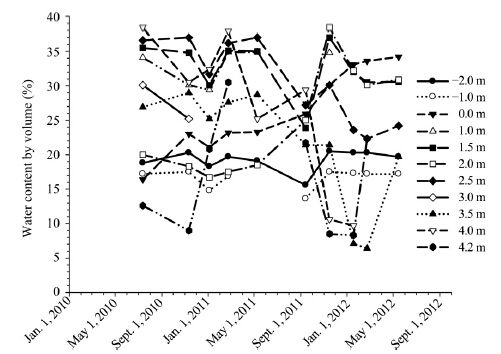 |
| Figure 16 Change in water content by volume with time in the control section |
Therefore, the new embankment with insulation boards and geotextiles exhibited less of a change in water content than did the control embankment, which showed the weaker effects of wetting-drying and freezing-thawing cycles in the new embankment. This could reduce the possibility of multi-collapse of the loess embankment.
4.2 Laboratory testingA laboratory model test was done to further verify the engineered effectiveness of the new embankment. The layout of the insulating boards and geotextile was similar to the field structure of the loess embankment. During the testing period, the water contents and ground temperature at different locations were monitored to analyze the thermal insulating and water-proofing effects, respectively.
The model soil was sampled near the field experimental site. The model soil was prepared and compacted layer by layer in the model box. The insulation board, geotextile, thermistors, and TDR water probes were placed as shown in Figure 17. The inner air temperature in the model box and the bottom temperature were automatically controlled by the cooling devices by circulating a refrigerant. The inner air temperature varied in a sinusoidal wave in the range of −15.2 °C to 16.2 °C. The bottom of the model soil was connected with water(an open system) and its temperature was set as 1 °C. The initial volumetric water content of the model soil was 36.3%. The duration for a freezing-thawing cycle was as long as 48 hours. The model test lasted for four total freezing-thawing cycles.
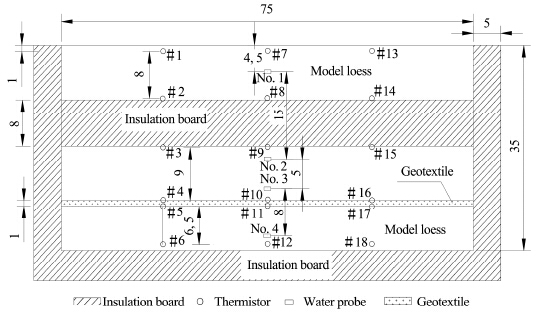 |
| Figure 17 Instrumentation in a model test verifying the engineered effectiveness of the new embankment(unit: cm) |
During the testing period, the ground temperatures and water contents were monitored to verify the preventive effectiveness of the new embankment against frost hazards and multi-collapse, particularly near the insulation board and geotextile.
4.2.1 Results of thermal regimesIn order to minimize the influence of environmental air temperature(outside the model box)on the soil temperature, the box wall was well insulated. The averages of the middle three temperatures at different heights were selected to analyze the thermal regimes. The ground and inner air temperatures are shown in Figure 18. The inner air temperature varied in a sinusoidal wave in agreement with the refrigerant temperature. The average ground temperatures at the first and second layers(above the insulation board)showed larger amplitude than those under the insulation board, such as from the third layer to the sixth layer. The upper soil above the insulation board was frozen when the air temperature remained negative. However, the lower soil under the insulation board was never frozen. This showed that the insulation board had a good thermal insulating effect.
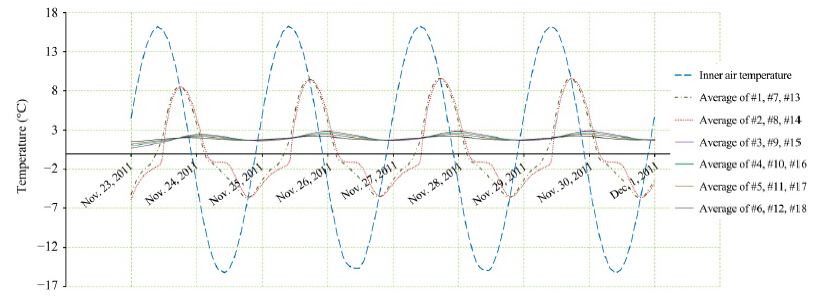 |
| Figure 18 Changes in ground temperatures with time at different locations in a model test |
Four water probes(Nos. 1-4)were placed in the central profile, as shown in Figure 17, with different depths of 4.5 cm, 19.5 cm, 24.5 cm, and 32.5 cm successively. The No. 1 probe was located above the insulation board. The No. 2 and No. 3 probes were located closely under the insulation board and on the surface of the geotextile. The No. 4 probe was located under the geotextile and close to the bottom. Figure 19 shows the variation in water content at different depths and the inner air temperature. The water content of the No. 1 probe above the insulation board varied more remarkably with the periodic undulation of the inner air temperature than did the other probes. It decreased when the air temperature became negative and it increased when the air temperature became positive. This showed a good agreement with the field observations.
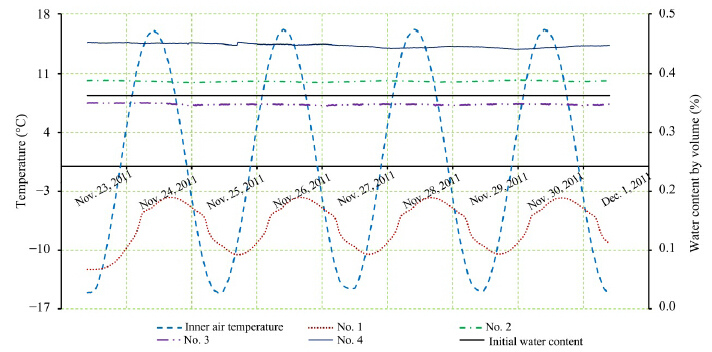 |
| Figure 19 Changes in water content by volume and inner air temperature with time at different locations |
The water contents of the No. 2 and No. 3 probes, which were located between the insulation board and the geotextile, remained nearly the same as the initial water content. This showed that the insulation board and geotextile all had a water-proofing effect. The water content of the No. 4 probe located near the bottom of model soil also remained constant but at a higher level, about 45%, because the bottom was connected with water. Therefore, the new embankment was not significantly influenced by the freezing-thawing cycle because of the thermal insulating effect of the insulation board.
5 Conclusions and further research needs 5.1 Main conclusionsWe conducted a research program to study the processes and mechanisms of secondary and multi-collapse of loess embankments, and to develop preventive measures. Based on numerous laboratory and field tests, we assessed the effects of wetting-drying and freezing-thawing cycles on the processes and mechanisms of loess collapse and proposed a countermeasure, which was verified in laboratory and field tests. Some conclusions are:
1)Investigations have proved that the collapsibility of compacted loess is related to the number of wetting-drying and freezing-thawing cycles it is exposed to. The secondary or multi-collapse is a primary trigger of loess road problems in seasonally frozen ground regions.
2)Wetting-drying cycles cause reduction of cohesion and density of compacted loess, which can weaken its compacted strength.
3)Open-system freezing-thawing cycles lead to the redistribution of soil water content, reduction of density, increase in areal porosity and the number of macro-pores, and the enlargement of pores. Closed-system freezing-thawing cycles cause reduction in cohesion and strength of compacted loess. These results show that freezing-thawing cycles can also weaken the strength and deteriorate the structure of compacted loess.
We also proposed and validated by laboratory modeling and field tests a mitigative measure consisting of an insulation board and geotextile installed on a test section of embankment. Field and laboratory observed data showed that the proposed new embankment can reduce the frost depth and prevent soil moisture from migrating, and thus mitigate the adverse effects of wetting-drying and freezing-thawing cycles on loess roads.
5.2 Further research needsSome works of this research program have been completed and others are still ongoing, as described above. Further research needs for better underst and ing of the processes and mechanisms of loess collapse and for helping perform the rest of the research works include:
1)Additional research on the processes and mechanisms of multi-collapse of compacted loess is needed. Many works have focused on the mechanisms on initial collapse of natural loess rather than on the secondary or multiple collapses, which may be the primary causes of loess road problems(e.g., cracks, differential settlement)in seasonally frozen ground areas following many years of operation. Field verification, causes, mechanisms, and quantitative evaluation of multi-collapse of compacted loess have not yet been completely resolved. Additionally, there is not yet a consensus on which parameter should be used to reasonably evaluate multi-collapse(e.g., coefficient of collapsibility or a collapse index as a means of evaluating the initial collapse). These are all needed for further research.
2)There is a need for quantitative research on the effects of wetting-drying or freezing-thawing cycles on the processes and mechanisms of multi-collapse from macroscopic and microscopic views, respectively, although there have been some descriptive reports on the effects of wetting-drying and freezing-thawing cycles. Additionally, certain relationships between macro- and micro-parameters pertaining to loess behaviors after wetting-drying and freezing-thawing cycles have not yet been established because of lack of consistency in testing conditions such as water content, pressure, soil type, and sample size. Not knowing these relationships makes it difficult to apply micro-parameters in actual engineering, which is always evaluated by various macro-parameters. Finally, the magnitude of multi-collapse induced by wetting-drying or freezing-thawing cycles has not yet been determined.
3)Quantitative research is needed on the processes, mechanisms, and magnitude of multi-collapse of loess roads induced by salinization, from macroscopic and microscopic views. The relationships between macro- and micro-parameters of compacted loess subjected to salinization must be understood to effectively evaluate and analyze the multi-collapse of loess roads.
4)Further quantitative studies are needed on effects of double or triple combinations of wetting-drying, freezing-thawing, and salinization-desalinization cycles, because their coupling effect undoubtedly occurs in actual loess engineering in arid and seasonally frozen ground areas. Investigations are rarely performed on these coupling effects on geotechnical properties and the collapse magnitude of compacted loess.
5)Development and verification of other preventive measures are required to reduce the damages related to loess multi-collapse and maintenance costs. The measure we propose here is not superior; it needs further improvement, such as the prevention of freezing-thawing and wetting-drying cycles on side slopes of loess roads. Additionally, the comprehensive and complete prevention of the initial and multiple collapses of loess roads, including treatments of the loess roadbed, side slopes and embankment and improvement of drainages, is needed to maintain long-term safe operation of loess roadways.
Acknowledgments: This work was supported by the National Key Basic Research Program of China(973 Program)(No. 2012CB026106), the Science and Technology Major Project of Gansu Province(No. 143GKDA007), the West Light Foundation of CAS for Dr. G. Y. Li, the Program for Innovative Research Group of the Natural Science Foundation of China(No. 41121061), and the Foundation of the State Key Laboratory of Frozen Soils Engineering of CAS(No. SKLFSE-ZT-11).| Bing H, He P, 2001. Experimental investigations on the influence of cyclical freezing and thawing on physical and mechanical properties of saline soil. Environmental Earth Sciences, 64(2): 431-436. DOI: 10.1007/s12665-010-0858-y. |
| Chamberlain EJ, Gow AJ, 1979. Effect of freezing and thawing on the permeability and structure of soils. Engineering Geology, 13(1-4): 73-92.DOI:10.1016/0013-7952(79)90022-X. |
| Chang D, Liu JK, 2013. Review of the influence of freeze-thaw cycles on the physical and mechanical properties of soil. Sciences in Cold and Arid Regions, 5(4): 457-460. DOI: 10.3724/SP.J.1226.2013.00457. |
| Czurda KA, Hohmann M, 1997. Freezing effect on shear strength of clayey soils. Applied Clay Science, 12(1-2): 165-187. |
| Derbyshire E, 2001. Geological hazards in loess terrain, with particular reference to the loess regions of China. Earth-Science Reviews, 54(1-3): 231-260.DOI:10.1016/S0012-8252(01)00050-2. |
| GB50025-2004, 2004.Code for Building Construction in Collapsible Loess Regions. Beijing: China Architecture and Building Press. |
| Graham J, Au VCS, 1985. Effects of freeze-thaw and softening on a natural clay at low stresses. Canadian Geotechnical Journal, 22(1): 69-78. DOI: 10.1139/t85-007. |
| Houston SL, Houston WN, Zapata CE,et al., 2001.Geotechnical engineering practice for collapsible soils. Geotechnical and Geological Engineering, 19: 333-355. DOI: 10.1023/A:1013178226615. |
| Hohmann-Porebska M, 2002. Microfabric effects in frozen clays in relation to geotechnical parameters. Applied Clay Science, 21(1-2): 77-87.DOI:10.1016/S0169-1317(01)00094-1. |
| Kay BD, Dexter AR,1992. The influence of dispersible clay and wetting/drying cycles on the tensile strength of a red-brown earth. Australian Journal of Soil Research, 30(3): 297-310. DOI:10.1071/SR9920297. |
| Li GY, Ma W, Jin HJ, et al., 2010.Experimental research on impact of freeze-thaw cycle on geotechnical properties of compacted loess. In: KwokC (ed.). Proceedings of the 63rd Canadian Geotechnical & 6th Canadian Permafrost Conference, Calgary, Alberta, Canada, pp. 431-435. |
| Li GY, Ma W, Mu YH, et al., 2011.Process and mechanism of impact of freezing and thawing cycle on collapse deformation of compacted loess. China Journal of Highway and Transport, 24(5): 1-5. |
| Li GY, Ma W, Zhao S, et al., 2012.Effect of freeze-thaw cycles on mechanical behavior of compacted fine-grained soil. In: Morse B, Dore G (eds.). Proceedings of the Fifteenth International Specialty Conference on Cold Regions Engineering, Quebec, Canada, pp. 72-81. DOI: 10.1061/9780784412473.008. |
| Li X, Zhang LM, 2009. Characterization of dual-structure pore-size distribution of soil.Canadian Geotechnical Journal, 46(2): 129-141. DOI: 10.1139/T08-110. |
| Malusis MA, Yeom S, Evans JC, 2011. Hydraulic conductivity of model soil-bentonite backfills subjected to wet-dry cycling. Canadian Geotechnical Journal, 48(8): 1198-1211. DOI: 10.1139/t11-028. |
| Mao YC, 2014. Study on mechanics of multi-collapse of loess subgrade in seasonal frozen regions. Ph.D. Thesis, University of Chinese Academy of Sciences. |
| Mu YH, Ma W, Li GY, et al., 2011. Quantitative analysis of impacts of freeze-thaw cycles upon microstructure of compacted loess. Chinese Journal of Geotechnical Engineering, 33(12): 1919-1925. |
| Nixon JF, LemG, 1984. Creep and strength testing of frozen saline fine-grained soils. Canadian Geotechnical Journal,21(3): 518-529. DOI: 10.1139/t84-054. |
| People's Republic of China Ministry of Construction (PRCMC), 2004.Code for Building Construction in Collapsible Loess Regions. Beijing: China Building Industry Press. |
| Qi JL, Vermeer PA, Cheng GD, 2006. A review of the influence of freeze-thaw cycles on soil geotechnical properties. Permafrost and Periglacial Process, 17: 245-252. DOI: 10.1002/ppp.559. |
| Sillanpaa M, Webber WR, 1961. The effect of freezing-thawing and wetting-drying cycles on soil aggregation. Canadian Journal of Soil Science, 41(2): 182-187. DOI: 10.4141/cjss61-024. |
| Sun JZ, 2005. Loessology. Hong Kong: Hong Kong Archaeological Society, pp. 19-24. |
| Zhang FY, Wang GH, Kamai T, et al., 2013. Undrained shear behavior of loess saturated with different concentrations of sodiumchloride solution. Engineering Geology, 155: 69-79.DOI:10.1016/j.enggeo.2012.12.018. |
 2015, 7
2015, 7


